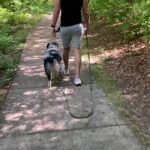The complaint I often hear from pet parents is that their dog PULLS ON THE LEASH. If their dog could talk to me, I bet the number one complaint would be that the pet parent pulls on the other end of the leash!
Remember Newton’s Third Law: Action and Reaction? It simply states, “For every action, there’s an equal and opposite reaction.” I wonder if Newton had a dog.
One of the most difficult concepts for a pet parent to understand and accept to be true is that if a dog is pulling, and the pet parent pulls back, the dog will continue to pull, and so will the pet parent, and on and on it goes.
All of the paraphernalia on the market that restrains your dog will help to some degree but will NEVER TEACH your dog to walk without pulling. Many of these devices, like harnesses, are used by pet parents to help prevent pulling on the dog’s neck. Proper training should never include pulling on the dog’s neck because we never want to injure the dog. It is also useless as far as training goes. But remember, you cannot correct a dog pulling on the leash by pulling the dog back!
A dog allowed to walk ahead of the pet parent and not at heel will generally not be well trained in other areas of obedience and behaviors like sit/stay, recall, and impulse control.
During training, a fifteen (15)-foot lead is used. The lead is held in the pet parent’s right hand, and the dog walks at heel on the left. The pet parent instructs the dog using their voice and body language, not the leash.
A dog that walks at heel without restraint responds to the pet parent’s voice and signals given through a specific type of collar and leash during training, which is devised not to cause any stress on the dog. This step in training a dog to heel through voice command leads to other training that includes come-when-called and social skills like passing a person or another dog on a walk or in a business environment like a store.
The key to training is that any inappropriate behavior redirected by using food rewards instead of correcting through training and teaching is a temporary fix, like a band-aid. It validates the unwanted behavior further as your dog ages.






